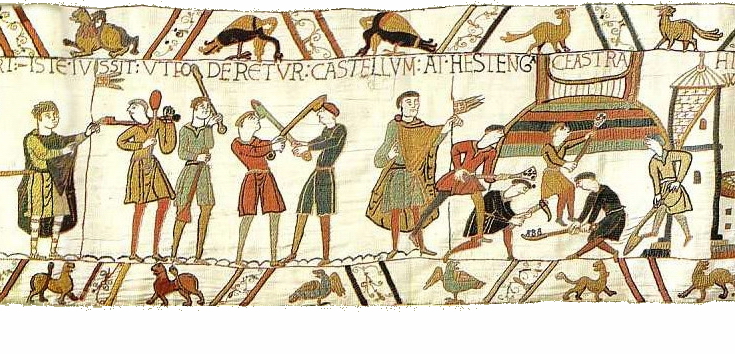Perhaps that is why I am drawn to Latin. Latin was a global Roman-era and medieval data standard for globally consistent communications. Anyone speaking or writing Latin could communicate with anyone else speaking or writing Latin throughout the Roman Empire or the Catholic Church.
When I first read through the Carmen in Latin portus ab antiquis Vimaci - the ancient port of Vimeu - at line 48 leapt out at me, as I had already read somewhere that the Norman invasion fleet departed from St Valery-sur-Somme, at the mouth of the Somme River. Indeed, the description of the port in the Carmen said that the Abbey of Saint Valery overlooked the port and that it was at the mouth of the Somme, so there could be no mistake.
So what or where was Vimaci? Why was the name Vimaci used by the Guy d'Amiens writing the Carmen instead of the name of the port, despite his being otherwise very economical in his text?
Vimeu is not a port or even a town. It was a medieval barony. The medieval barony spread inland from the coast of the Somme covering a pretty large area. As soon as I saw this, I thought <barony naming convention/>!
The cleric who wrote the Carmen adopted a convention of ignoring local place names in favour of referencing the barony associated with the local place and supplementing the barony name with locally descriptive features. If this was true for Guy d'Amiens, it might be true for other medieval clerics as well.
A barony naming convention would explain why the Normans called it the Battle of Hastings instead of naming it for the battlefield. The battle took place in the Rape (barony) of Hastings on land that was subject to Hastings' jurisdiction. The Saxons called it the Battle of Senlac according to Orderic Vitalis, after the local name of the place. Senlac means "sandy loch" and would fit the wide, sandy Brede Valley flood plain through which the estuarine Brede River meandered.
A barony naming convention would explain why the makers of the Bayeux Tapestry wrote that the fleet sailed for Pevensey if it landed in the valley. The ports of Brede and Petit Iham were limbs of Pevensey, owing the service of ships, men and boys to the League of Pevensey each year for fixed terms.
| 38 | HIC WILLELM[US] DUX IN MAGNO NAVIGIO MARE TRANSIVIT ET VENIT AD PEVENESAE | Here Duke William in a great fleet crossed the sea and came to Pevensey |

A barony naming convention would explain why the raiding parties went to loot Hastings though it is clear from the pictures in the tapestry - and particularly the depiction of the boats with open oar ports - that the camp was some remote distance from Hastings along the coast.
| 40 | ET HIC MILITES FESTINAVERUNT HESTINGA UT CIBUM RAPERENTUR | and here the knights have hurried to Hastings to seize food |

A barony naming convention would explain why the makers of the Bayeux Tapestry wrote that the a motte was erected at the Hastings camp. Iham Hill was a parish in the jurisdiction of medieval Hastingas, probably going back to the original 790 King Offa charter giving Hastings, Pevensey, Londonwick and other ports and trade privileges to the Abbey of Saint-Denis. The camp of the invasion force was in the Rape of Hastings.
| 45 | ISTE JUSSIT UT FODERETUR CASTELLUM AT HESTENGA CEASTRA | He ordered that a motte should be dug at Hastings Camp | |

The same barony naming convention would explain why the army marched from Hastings to go to battle. If the building shown is the rebuilt "fortress lately razed" of St Leonard's Church on Iham Hill, then it makes sense. St Leonard's was a parish of Hastings, in the Rape of Hastings.
| 48 | HIC MILITES EXIERUNT DE HESTENGA ET VENERUNT AD PR[O]ELIUM CONTRA HAROLDUM REGE[M] | Here the knights have left Hastings and have come to the battle against King Harold |

Hastinga being sacked is clearly different to Hastinga Ceastra where they have camped, and both look different to the fortified place from which the army marches. If they are all named Hastings because of a Barony Naming Convention, then these diverse scenes of the Bayeux Tapestry which seem to imply three different places may finally make sense.
I am not enough of a medieval scholar to know whether others have detected the use of a barony naming convention before in other medieval clerical works, but I am very keen to find out!

No comments:
Post a Comment